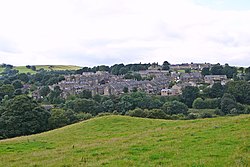Holywell Green
| Holywell Green | |
| Yorkshire West Riding | |
|---|---|
 Holywell Green, from Broad Carr Lane | |
| Location | |
| Grid reference: | SE089198 |
| Location: | 53°40’30"N, 1°51’59"W |
| Data | |
| Population: | 3,178 (2011) |
| Post town: | Halifax |
| Postcode: | HX4 |
| Dialling code: | 01422 |
| Local Government | |
| Council: | Calderdale |
| Parliamentary constituency: |
Calder Valley |
Holywell Green is a village in the West Riding of Yorkshire, a mile and a half south-west of Elland, three and a half miles south of Halifax and four miles north-west of Huddersfield.
History

Holywell Green was recorded in the Domesday Book as a small hamlet within the township of Stainland. It gets its name from St Helen's Well which was known within the area during the Middle Ages. The original location of this well is uncertain.
About the village
Shaw Park
Shaw Park is the largest park in the area. The main entrance is located off Station Road. The park was the garden of Brooklands House until the house's demolition in 1930. In 1955, Raymond Shaw gave the garden to Elland UDC after which it became a public park. It has a playground, astroturf 5-a-side football pitch, well, ornamental lake, reed pond, arches, three follies and woods. The follies are located at the top of the park and were built by John Shaw as aviaries. The park is accessible by four entrances: Shaw Lane next to Brooklands Avenue, Shaw Lane next to Brooklands Close, the very bottom of Shaw Lane and Station Road.
The Shaw Park Restoration Group was founded in 2010, to restore the park back "to its former glory". Money for restoration has been lacking because of Calderdale Council spending cuts.[1][2]
St Helen's Well

St Helen's Well is mentioned in John Watson's History and Antiquities of the Parish of Halifax, 1775. He gives no description but says a Roman Catholic chapel dedicated to St Helen nearby had been converted into a cottage, but in its walls was a large stone known locally as "the Cross". Both the Well and the Cross were sometimes visited by "strangers", who were assumed by the inhabitants to be Catholic pilgrims. Watson also possessed a deed which mentioned a grant made to "Henry de Sacro Fonte de Staynland", dated between 1279 and 1324.[3]
The exact location of the well is uncertain. The traditional site is marked by a stone trough in the village, on Station Road, above which is the inscription "Holy Well Improved 1843". This well is now dry. Its restoration in 1843 may have been connected with a general resurgence of local interest in holy wells that took place around that time, sparked off by the rise of the temperance movement.[4] The Halifax Guardian for September 1842 described crowds gathering around Well Head spa in Halifax, jostling each other in their eagerness to taste the waters, and similar scenes may have occurred around this well. In the late 19th century, the stone trough had cracked and was leaking. It was further restored in 1977.
However, local historian J.A. Heginbottom claims that this stone trough "has no historical basis for its dedication and is purely fanciful". Heginbottom locates the true site of St Helen's Well about one kilometre away, near Helen Hill Farm on Jagger Green Lane. A spring still flows at this spot, filling a Victorian-era stone cistern.[5]
An early 19th-century engraving of the well can be found in The Legendary Lore of the Holy Wells of England by Robert Charles Hope.[6]
Bradley Hall Golf Club
Opposite Burrwood Way's junction with Stainland Road is the road to Bradley Hall Golf Club. The clubhouse is named Bradley Hall. The golf course spreads along the side of the hill below Stainland.
Bradley Hall itself was built in the 16th century and was badly damaged by a fire in 1629.[7] Local places were named after the hall, including Bradley Court, Bradley Lane, Bradley Farm and Little Bradley, all in Greetland, and Bradley View in Holywell Green.
Outside links
| ("Wikimedia Commons" has material about Holywell Green) |
- Bradley Hall Golf Club
- The Rock Hotel
- The Shaw Park Restoration Group
- The Holy Well Inn Action Group
References
- ↑ "Jason in crusade to save park from ruin". Halifax Courier. 8 November 2010. Archived from the original on 12 March 2016. https://web.archive.org/web/20160312104347/http://www.halifaxcourier.co.uk/news/calderdale/jason-in-crusade-to-save-park-from-ruin-1-3000166.
- ↑ "Solvay donates £1,000 to Shaw Park Restoration Group". Yorkshire Live. 22 June 2013. https://www.examinerlive.co.uk/news/west-yorkshire-news/solvay-donates-1000-shaw-park-4884819.
- ↑ Watson, John (1775). The History and Antiquities of the Parish of Halifax. London: T. Lowndes. pp. 279–281. https://books.google.com/books?id=hDlTAAAAcAAJ&pg=PA279.
- ↑ Heginbottom, J.A. (1988). "Early Christian Sites in Calderdale". Transactions of the Halifax Antiquarian Society 1988. p. 8.
- ↑ Heginbottom 1988, p. 13.
- ↑ Hope, Robert Charles (1893). The Legendary Lore of the Holy Wells of England. London: Elliot Stock. p. 172. https://archive.org/details/legendaryloreofh00hope/page/172/mode/2up.
- ↑ Watson 1775.